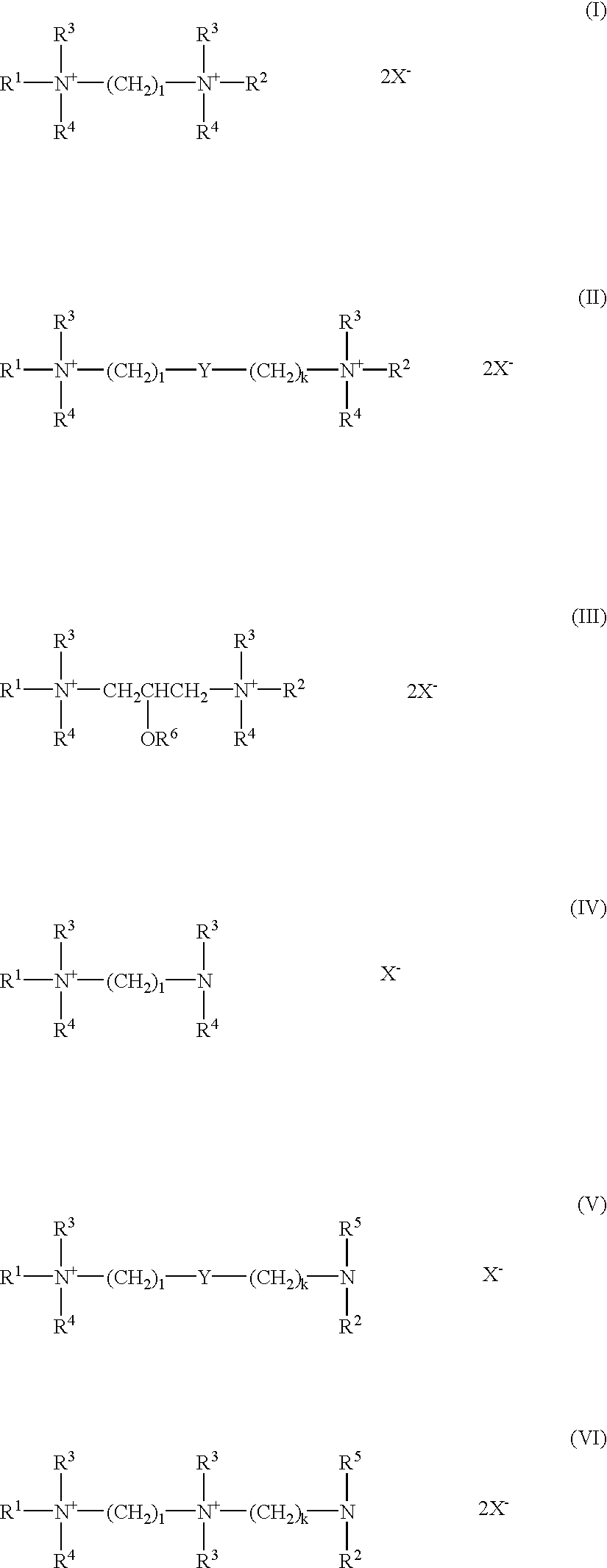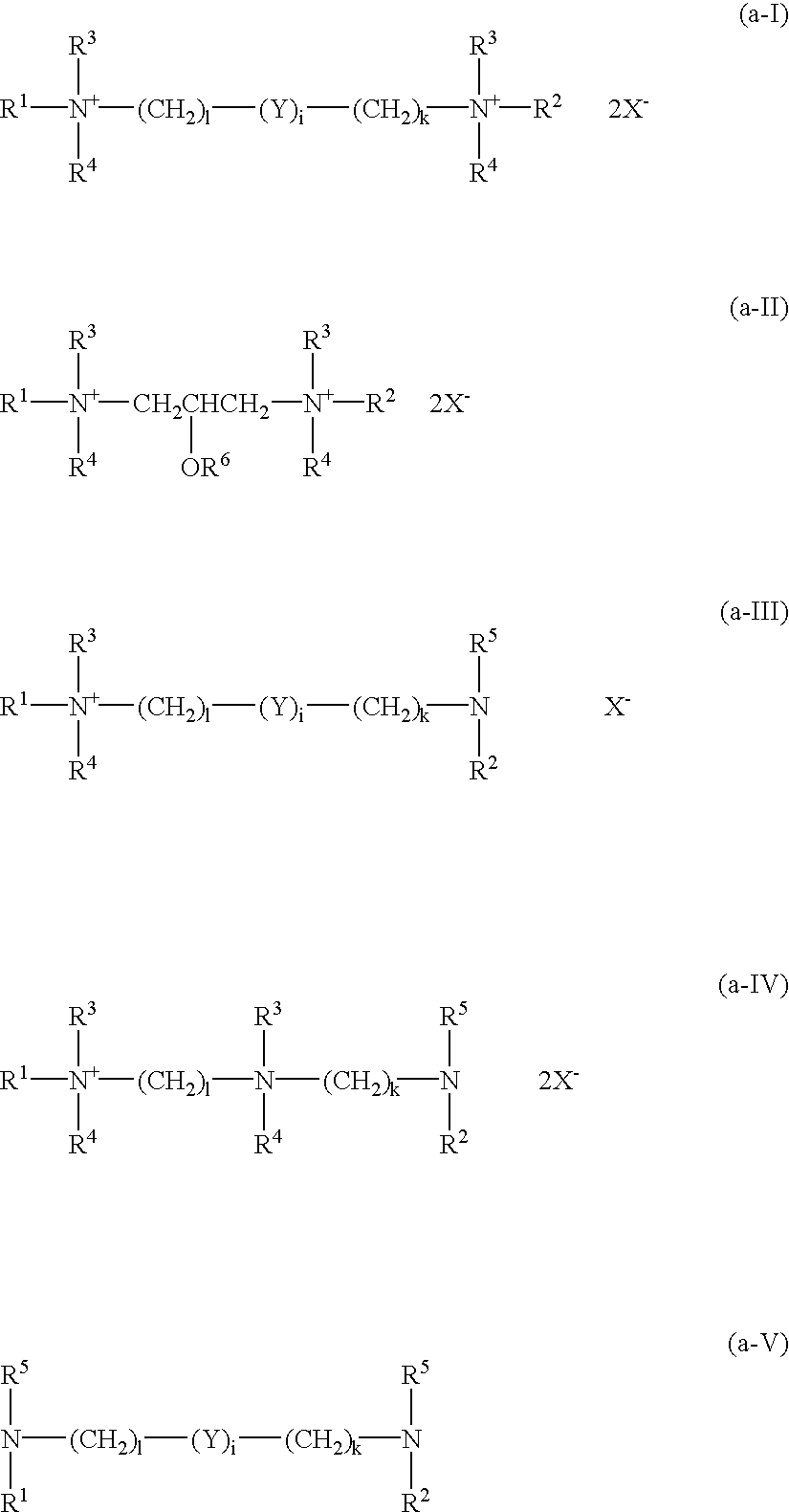Softener composition
a technology of softener and composition, applied in the field of softener composition, can solve the problems of quaternary ammonium salt slimy feeling, deterioration of water absorption properties of cotton towels, and unresolved problems, and achieve the effects of reducing the number of softeners, and improving the softness of the skin
- Summary
- Abstract
- Description
- Claims
- Application Information
AI Technical Summary
Benefits of technology
Problems solved by technology
Method used
Image
Examples
synthesis example 1
a-1: ##STR7##
Methyl monoethanolamine and acrylonitrile were subjected in an usual manner to the Michael addition reaction, and the reaction product was introduced into an autoclave made of stainless steel, followed by adding ethanol as the solvent and Raney nickel as the catalyst. The atmosphere in the autoclave was replaced by nitrogen and then by hydrogen, and the mixture was reacted for 3 hours at a temperature of 110.degree. C. at a pressure of 10 kg / cm.sup.2 hydrogen. Then, an aqueous solution of formalin in a 2.2-fold molar amount relative to the amine was injected into the autoclave, and the reaction was further continued for 5 hours. After cooling, the resultant reaction product was distilled to give N-hydroxyethyl-N,N',N'-tetramethyl propane diamine.
Then, stearic acid and N-hydroxyethyl-N,N',N'-tetramethyl propane diamine were esterified by a conventional esterification method, and the resulting ester was subjected to quaternarization reaction with methyl chloride, to give ...
synthesis example 2
a-2: ##STR8##
An esterification reaction product of dimethyl ethanolamine and stearic acid and an esterification reaction product of choline chloride and monochloroacetic acid were synthesized in an usual method. These 2 compounds were dissolved in equimolar amounts respectively in ethanol and reacted for 6 hours under reflux. The ethanol was distilled away under reduced pressure and the reaction product was purified in an usual manner to give Compound a-2.
synthesis example 3
a-3: ##STR9##
The dehydration condensation reaction of stearic acid with N-hydroxyethyl ethylene diamine was carried out, and the reaction product was hydrolyzed and distilled to give N-stearoyl-N'-hydroxyethyl ethylene diamine. It was dissolved in ethanol, and 1.1-fold equivalents (based on the amine) of formalin was added dropwise thereto under reflux, then 1.1-fold equivalents (based on the amine) of formic acid was added dropwise thereto, and the mixture was aged for 5 hours. The reaction product was further quaternarized with methyl chloride to give N-stearoylaminoethyl-N-hydroxyethyl-N,N-dimethyl ammonium chloride.
This compound and dimethyl glycine were subjected to usual esterification reaction to give Compound a-3.
PUM
| Property | Measurement | Unit |
|---|---|---|
| boiling temperature | aaaaa | aaaaa |
| temperature | aaaaa | aaaaa |
| weight | aaaaa | aaaaa |
Abstract
Description
Claims
Application Information
 Login to View More
Login to View More - R&D
- Intellectual Property
- Life Sciences
- Materials
- Tech Scout
- Unparalleled Data Quality
- Higher Quality Content
- 60% Fewer Hallucinations
Browse by: Latest US Patents, China's latest patents, Technical Efficacy Thesaurus, Application Domain, Technology Topic, Popular Technical Reports.
© 2025 PatSnap. All rights reserved.Legal|Privacy policy|Modern Slavery Act Transparency Statement|Sitemap|About US| Contact US: help@patsnap.com



